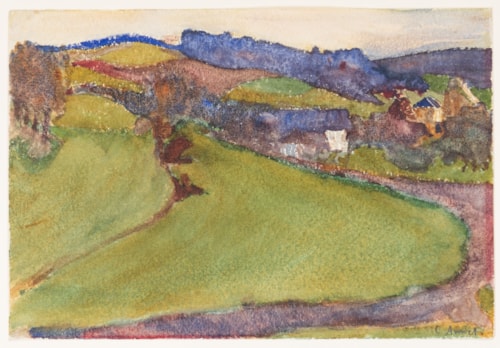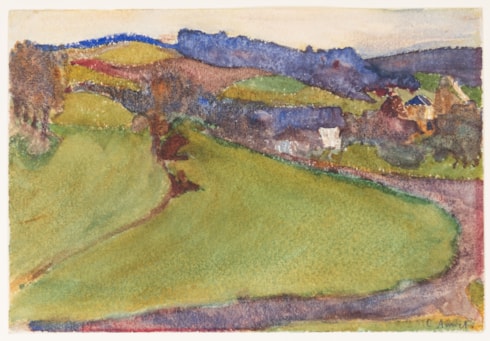
Cuno AMIET
Solothurn 1868 - Oschwand 1961
Biography
A pioneer of modernism in Switzerland, Cuno Amiet began his training as an artist in 1883, encouraged by the Swiss landscape painter Frank Buscher. Between 1886 and 1888 he studied at the Akademie der Bildenden Künste in Munich, where he met and befriended Giovanni Giacometti (who was to be the father of the sculptor Alberto Giacometti). In October 1888 both artists moved to Paris to study at the Académie Julian, and Amiet’s portrait of Giacometti was accepted at the Salon the following year. In May 1892 he visited the artist’s colony at Pont-Aven, where he lived and worked just over a year. Amiet was strongly influenced by the work of several of the artists of the Pont-Aven school, notably Emile Bernard, Paul Gauguin, Roderic O’Conor, Paul Sérusier and Armand Seguin, who encouraged him to take up printmaking. He exhibited at the Salon des Indépendants in 1893, but the same year had to return to Switzerland for lack of funds. He established a studio in Hellsau, and in 1894 an exhibition of work from his Breton period was mounted at the Kunsthalle in Basel, although it was poorly received by both the public and critics. Three years later Amiet received a commission to paint a frieze intended for the Paris Exposition Universelle of 1900, in collaboration with Giovanni Giacometti, Ferdinand Hodler – who was to become a close friend and a particular influence on the younger artist – and Giovanni Segantini. Although the work was never executed, a painting by Amiet won a silver medal at the Exposition Universelle, and he began to achieve a degree of commercial success as a portrait and landscape painter. In 1898 the newly-married artist settled in the Bernese village of Oschwand in the Upper Aargau, where he lived and worked for the remainder of his career.
Amiet was associated with the Vienna Secession, where he exhibited some thirty paintings in 1904, and in 1906 he became a member of Die Brücke, the German avant-garde group, alongside Ernst Ludwig Kirchner, Max Pechstein and Karl Schmidt-Rotluff. Amiet’s large home and studio in Oschwand, built for him in 1908, became a meeting place for numerous artists and writers, and it was there that he taught his many pupils. It was also where he exhibited and sold his works – landscapes, portraits (including numerous self-portraits) and still life subjects – to collectors, since for the most part Amiet seems to have avoided working with art dealers and galleries. In 1910 he began working on an important public commission, a mural of The Fountain of Youth for the Kunsthaus in Zurich, and in later years earned several further commissions for wall paintings. Following the death of Hodler in 1918 Amiet was established as the foremost painter in Switzerland. A large exhibition of his work was held at the Kunstmuseum in Bern to celebrate the artist’s sixtieth birthday in 1928. Three years later, however, around fifty of his most significant paintings, including many early Breton works, were destroyed in a fire in the Glaspalast in Munich. Having enjoyed a very long career of over seventy years, Amiet died in 1961, at the age of ninety-three. Works by Amiet are today in the collections of several museums in Switzerland, as well as the Van Gogh Museum in Amsterdam, the Brücke Museum in Berlin and the Musée d’Orsay in Paris, among others.


